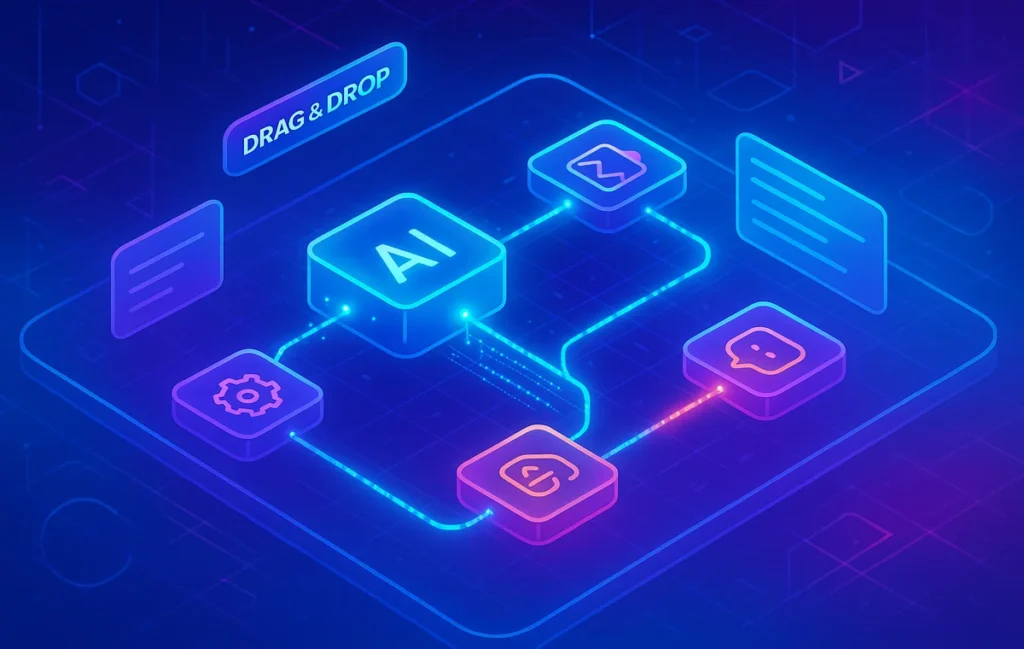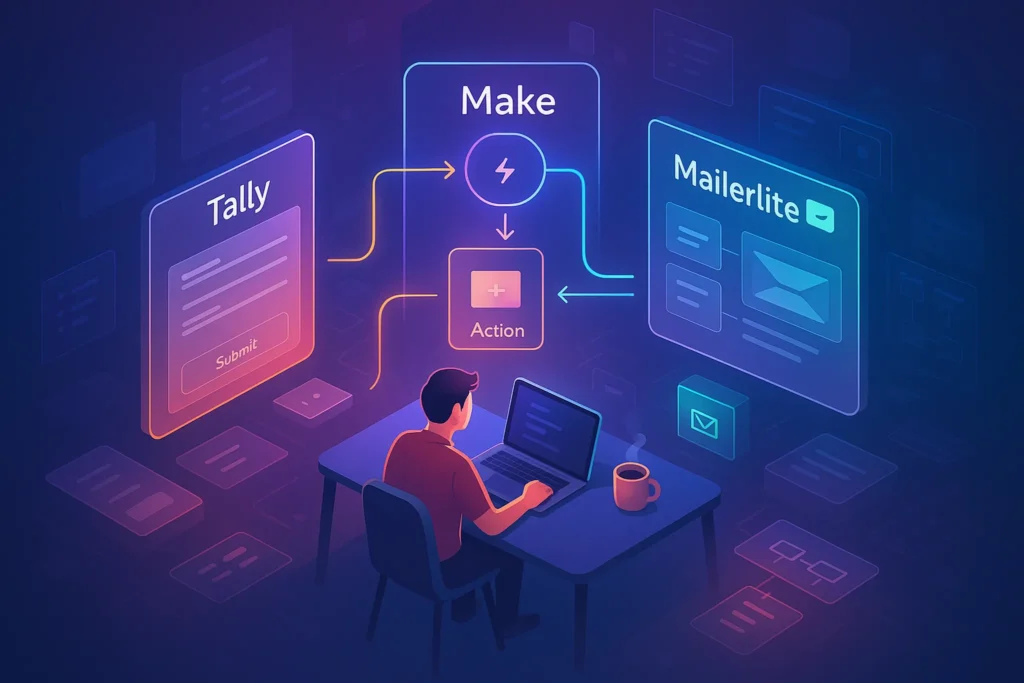🤖 Why No-Code AI Workflows Are a Game-Changer
In 2025, AI isn’t just about smart assistants or chatbots—it’s about embedding intelligence into the very workflows that run your business. From automating lead qualification to generating HR documents, AI-native workflow builders now let non-technical teams create powerful automations without a single line of code.
Traditional workflow platforms handled triggers and actions well, but they struggled with nuance—like interpreting natural language or classifying customer intent. That’s where AI-native tools step in. Platforms such as Make.com, n8n with AI plugins, Pipedream, Latenode, Levity AI, and Zapier AI combine automation logic with AI-powered decisions, unlocking use cases that would have required developers just a few years ago.
💡 Nerd Tip: If you’re new to automation, check out our Workflow Automation 101. Once you understand the basics of triggers and actions, AI-native builders take things to a whole new level.
⚡ Make.com: Visual Power Meets AI
Make.com has long been a favorite among no-code professionals for its visual drag-and-drop canvas. In 2025, it expanded with AI modules that let users classify text, summarize emails, or even generate copy within a workflow.
For example, a marketing team can capture form submissions, classify leads with GPT-powered scoring, and route high-value ones straight into their CRM—all inside Make. Pricing remains competitive, starting free for hobbyists and scaling reasonably for pro users.
The main challenge? Complexity. While it can handle advanced workflows, beginners may find the interface overwhelming compared to simpler tools.
💡 Nerd Tip: Pair Make with insights from Best Workflow Automation Tools for Solopreneurs if you’re starting small but want room to grow fast.
🔄 n8n + AI Plugins: Open Source Flexibility
n8n is the open-source powerhouse in this comparison. It gained traction for giving teams self-hosted control, and in 2025, its AI plugins transformed it into a serious AI automation contender. With support for OpenAI, Hugging Face, and custom models, n8n lets teams run AI inference on their own servers for maximum privacy.
Developers and advanced solopreneurs love its flexibility: you can chain AI-powered text classification with API calls to Slack or CRMs, all while keeping data in-house. However, this power comes with a steeper learning curve than tools like Zapier AI.
💡 Nerd Tip: If data security or customization is critical, n8n outshines most commercial platforms.
🌐 Pipedream: Developer-Friendly AI Workflows
Pipedream bridges the gap between developers and no-code builders. While it offers a drag-and-drop editor, its real strength is letting you write lightweight code snippets where needed. In 2025, Pipedream expanded with AI components that allow tasks like extracting key data from PDFs, running language detection, or automating translations.
A popular use case: integrating AI into API-heavy environments. Developers can orchestrate workflows that pull from multiple APIs, apply AI to clean or enrich the data, and push results to dashboards—all in one place.
💡 Nerd Tip: Consider Pipedream if your workflows require both code and no-code flexibility. It’s perfect for hybrid teams.
⚙️ Latenode: AI-First No-Code Builder
Latenode positions itself as a native AI automation platform. Unlike older tools that bolted on AI later, Latenode was designed from the ground up to use AI for decisions, summaries, and content generation.
Its edge is simplicity. With templates for common AI use cases—like analyzing customer feedback or automating content planning—it appeals to non-technical founders. While still newer compared to Make or Zapier, it’s gaining adoption for being fast, intuitive, and affordable.
💡 Nerd Tip: Pair Latenode with our guide on How to Automate Content Planning with AI Tools to see how it excels in creative workflows.
🧩 Levity AI: No-Code Machine Learning
Levity AI isn’t about connecting apps—it’s about bringing custom machine learning into no-code workflows. Teams can train their own classifiers (for example, to detect sentiment in support tickets or tag product photos) without writing ML code.
In 2025, Levity’s pricing dropped, making it more accessible to SMBs. The downside is that it’s not a general automation tool—you’ll still need another platform like Zapier or Make to orchestrate broader workflows.
💡 Nerd Tip: Use Levity when off-the-shelf AI models aren’t enough. Training your own model without code is its superpower.
⚡ Zapier AI: The Familiar Giant Evolves
Zapier has been the entry point for no-code automation for years, but in 2025, Zapier AI turned it into something much smarter. Its AI actions now let you interpret text, draft responses, and even auto-build Zaps from natural language prompts.
Ease of use is unmatched: beginners can describe what they want in plain English, and Zapier AI creates the workflow. For small teams and solopreneurs, this is the most accessible way to add AI to daily workflows. Pricing is higher than competitors, but the time saved in setup often offsets the cost.
💡 Nerd Tip: If you’re just entering the space, Zapier AI is the friendliest on-ramp into AI Workflow Builders: The New No-Code Revolution.
📊 Side-by-Side Comparison
| Tool | Ease of Use | AI Integrations | Scalability | Pricing |
|---|---|---|---|---|
| Make.com | Moderate | Strong, broad | High | Mid-range |
| n8n + AI | Complex | Customizable | Very High | Free/Open-Source |
| Pipedream | Moderate | Developer-heavy | High | Flexible tiers |
| Latenode | Easy | AI-native | Growing | Affordable |
| Levity AI | Moderate | Custom ML | Limited scope | Mid-tier |
| Zapier AI | Very Easy | Mainstream AI | High | Premium |
💡 Nerd Tip: Match tool to your growth stage. Zapier AI helps you start, Make.com scales, n8n gives you control, and Levity AI adds custom intelligence.
⚡ Ready to Build Smarter Workflows?
Explore AI-native workflow builders like Make, Zapier AI, and n8n. Automate decisions, content, and data flow—no coding required.
🧪 Case Study: From 4 Hours to 30 Minutes
A mid-sized marketing team used to spend nearly four hours daily qualifying leads. Every submission had to be manually checked, scored, and routed to the right rep. In 2025, they adopted Make.com with GPT-powered classification. Now, when a lead form is submitted, the workflow automatically reads the message, scores intent, and routes hot leads directly to the CRM with Slack alerts. The entire process takes under 30 minutes a day, saving over 60 hours monthly.
On the freelancer side, one consultant shared on X:
“Zapier AI just built me an invoicing + reminder workflow in 10 minutes. I used to dread month-end. Now it’s done in the background.”
💡 Nerd Tip: Real-world stories highlight how automation shifts from “nice-to-have” to mission-critical.
📊 Benchmarks That Prove the Difference
Comparisons become clearer when backed by numbers. In independent 2025 testing:
-
Zapier AI could auto-generate a draft workflow from plain English in 2–3 minutes, while Make.com setups averaged 15–20 minutes but offered more customization.
-
n8n self-hosted costs as little as $50/month in server resources for SMBs, compared to $600+/month for equivalent Zapier premium plans.
-
Adoption rate: Over 60% of SMBs report having at least one AI-native automation live in production, double the number from 2023.
-
Error reduction: Teams using AI-enhanced validation workflows (Levity AI + Zapier AI) saw data-entry mistakes drop by 45%.
💡 Nerd Tip: Benchmarks expose the trade-off—Zapier wins in speed, n8n in cost control, Make in depth.
🌐 Ecosystem Fit: Picking the Right Stack
Choosing an AI workflow builder isn’t just about the tool—it’s about how it fits your broader ecosystem. Zapier AI thrives in SaaS-heavy startups already living in Google Workspace, Notion, and HubSpot. n8n shines in privacy-conscious teams that need control over their servers and integrations. Pipedream is perfect for developer-centric stacks where APIs and custom scripts are the norm. Latenode fits lightweight, AI-first founders who want pre-built templates. Levity AI excels when you need custom ML classification without hiring data scientists.
💡 Nerd Tip: Before choosing, map out your top 5 apps. The best builder is the one that plugs into them with minimal friction.
⚠️ Mistakes & Pitfalls to Avoid
As with any new wave of tech, many teams stumble. One common pitfall is over-automation—letting AI make decisions in contexts where human oversight is critical, such as legal approvals or sensitive HR cases. Another is vendor lock-in: building too many mission-critical processes in one tool without a backup plan. If pricing shifts or an API changes, your workflow could break overnight. Finally, chasing “automation for automation’s sake” often backfires, adding complexity instead of clarity.
💡 Nerd Tip: Audit your automations quarterly. Kill the ones that don’t save measurable time or reduce real errors.
🔮 Beyond 2025: AI Workflows Become Agents
Looking forward, the line between workflow builders and AI agents is blurring. Already, Zapier AI and Make are testing features where the platform not only runs workflows but suggests new automations proactively. Imagine an AI agent analyzing your Slack usage and building an automation to summarize threads without being asked.
By 2027, expect agent-based workflows where tools don’t just follow rules—they negotiate, test, and integrate new apps on your behalf. For example, an AI agent could identify a new social media scheduling app, test it with sample data, and integrate it into your content pipeline automatically.
💡 Nerd Tip: Future-proof by choosing platforms with clear AI-agent roadmaps. The best automations won’t be built by you—they’ll be discovered by your AI.
📬 Want More Smart AI Tips Like This?
Join our free newsletter and get weekly insights on AI workflows, no-code tools, and future automation strategies—delivered straight to your inbox.
🔐 100% privacy. No noise. Just value-packed automation tips from NerdChips.
🧠 Nerd Verdict
AI workflow builders in 2025 are no longer experiments—they’re the backbone of modern automation stacks. Zapier AI democratizes access, Make.com scales with complexity, n8n secures data, Pipedream blends code with automation, Latenode pushes AI-first simplicity, and Levity AI adds custom machine learning. NerdChips’ take? Don’t think of these tools as “extras.” They’re the new operating system for how work gets done without writing code.
❓ FAQ: Nerds Ask, We Answer
💬 Would You Bite?
If you could build your first AI workflow today, would you start with lead scoring, content generation, or automating repetitive admin tasks?
Crafted by NerdChips for builders who want AI workflows without writing a single line of code.



